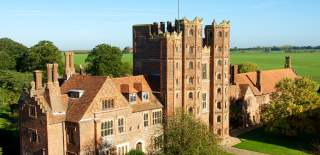Tudor Colchester
The Tudor period, from the end of the 15th century to the beginning of the 16th, was a period of great change in Colchester as the two large religious sites in the city - St Botolph's Priory and St John's Abbey - were closed by Henry VIII. What remains can be visited today and gives an indication of their size and significance at the time.
However, the Tudor period was also a time of relative prosperity in the town and significant buildings such as the Red Lion Hotel and Tymperleys tea room with their familiar black and white Tudor facades still stand in the city centre. Perhaps most impressive of all however is the nearby Layer Marney Tower, just a short drive from the city centre, and holder of the title of tallest Tudor Gatehouse in England.
Upon Elizabeth I's ascent to the throne Colchester became a haven for Protestants fleeing from Flanders where they had been defeated in a rebellion against Catholic Spain. Many of them were skilled weavers, and it was through this Dutch community that Colchester became famous for high-quality cloths. The district where most of the Flemish weavers lived and worked is known to this day as the Dutch Quarter, and many of their timber framed houses still stand in this historical part of the city. Their influence can also be seen in Bourne Mill, a National Trust property close to the city centre.

